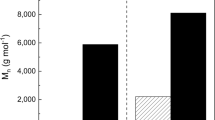Abstract
Copolyesters containing poly(ethylene terephthalate) (PET) and poly(ε-caprolactone) (PCL) were synthesized from PET and PCL homopolymers by transesterification reaction at 270°C in the presence of catalyst. The copolyesters were characterized by13C-NMR and differential scanning calorimetry (DSC). The degradation behavior of PCL byPseudomonas sp. lipase in buffer solution (pH 7) and tetrahydrofuran (THF) was investigated by gel permeation chromatography (GPC) and1H-NMR. From these experiments, it was found thatPseudomonas sp. lipase acted endoenzymatically on PCL. Using this lipase, degradation tests for PET/PCL copolyesters whose PCL content was below 50% by weight were also performed in buffer solution (pH 7). However, evenPseudomonas sp. lipase with high degradation activity on PCL did not easily degrade the PCL unit in PET/PCL copolyesters.
Similar content being viewed by others
References
G. Swift (1993)Acc. Chem. Res. 26 105–110.
M. A. Cole (1990)ACS Symp. Ser. 433 76–95.
Y. Inoue and N. Yoshie (1992)Prog. Polym. Sci. 17 571–610.
M. S. Reeve, S. P. McCarthy, and R. A. Gross (1993)Macromolecules. 26 888–894.
S. J. Huang, J. P. Bell, J. R. Knox, H. Atwood, D. Bansleben, M. Bitritto, W. Borghard, T. Chapin, K. W. Leong, K. Natarjan, J. Nepumuceno, M. Roby, J. Soboslai, and N. Shoemaker (1976) in J. M. Sharpley and A. M. Kaplan (Eds.),Proceedings of the 3rd International Biodegradation Symposium, Applied Science, London, pp. 731–741.
W. J. Bailey, Y. Okamoto, W.-C. Kuo, and T. Narita (1976) in J. M. Sharpley and A. M. Kaplan (Eds.),Proceedings of the 3rd International Biodegradation Symposium, Applied Science, London, pp. 765–773.
Y. Tokiwa, T. Suzuki, and T. Ando (1979)J. Appl. Polym. Sci. 24 1701–1711.
Y. Tokiwa and T. Suzuki (1981)J. Appl. Polym. Sci. 26 441–448.
K. E. Gonsalves, X. Chen, and J. A. Cameron (1992)Macromolecules. 25 3309–3312.
J. E. Potts (1978) in H. H. G. Jellinek (Ed.),Aspects of Degradation and Stabilization of Polymers, Elsevier, Amsterdam, pp. 617–657.
A. M. Kotliar (1981)J. Polym. Sci. Macromol. Rev. 16 367–395.
V. V. Korshak and V. V. Vasnev (1989) in G. Allen (Ed.),Comprehensive Polymer Science, Vol. 5, Pergamon Press, Oxford, pp. 135–137.
F. Pilati (1989) in G. Allen (Ed.),Comprehensive Polymer Science, Vol. 5, Pergamon Press, pp. 293–294.
G. Montaudo, M. S. Montaudo, E. Scamporrino, and D. Vitalini (1992)Macromolecules 25 5099–5107.
Y. Tokiwa (1984)Kobunshi. 33(5), 378–381.
S. J. Huang (1985) in H. F. Market al. (Eds.),Encyclopedia of Polymer Science and Engineering, Vol. 2, Wiley, New York, pp. 220–243.
R. D. Fields, F. Rodriguez, and R. K. Finn (1974)J. Appl. Polym. Sci. 18 3571–3579.
Y. Tokiwa, T. Ando, and T. Suzuki (1976)J. Ferment. Technol. 54(8), 603–608.
W. J. Cook, J. A. Cameron, J. P. Bell, and S. J. Huang (1981)J. Polym. Sci. Polym. Lett. Ed. 19 159–165.
C. G. Pitt, F. I. Chasalow, Y. M. Hibionada, D. M. Klimas, and A. Schindler (1981)J. Appl. Polym. Sci. 26 3379–3387.
C. V. Benedict, W. J. Cook, P. Jarrett, J. A. Cameron, S. J. Huang, and J. P. Bell (1983)J. Appl. Polym. Sci. 28 327–334.
C. V. Benedict, J. A. Cameron, and S. J. Huang (1983)J. Appl. Polym. Sci. 28 335–342.
S. C. Woodward, P. S. Brewer, F. Moatamed, A. Schindler, and C. G. Pitt (1985)J. Biomed. Mater. Res. 19 437–444.
Y. Tokiwa, T. Suzuki, and K. Takeda (1988)Agr. Biol. Chem. 52(8), 1937–1943.
Y. C. Kim, H. S. Jun, H. N. Chang, and S. I. Woo (1992)J. Kor. Inst. Chem. Eng. 30(6), 718–724.
Y. Tokiwa, T. Ando, T. Suzuki, and K. Takeda (1990)ACS Symp. Ser. 433 136–148.
H. R. Kricheldorf (1978)Makromol. Chem. 179 2133–2143.
R. Yamadera and M. Murano (1967)J. Polym. Sci. Part A-1. 5 2259–2268.
Y. Tokiwa and T. Suzuki (1977)Nature. 270 76–78.
Y. Tokiwa and T. Suzuki (1978)Agr. Biol. Chem. 42(5), 1071–1072.
Author information
Authors and Affiliations
Rights and permissions
About this article
Cite this article
Jun, H.S., Kim, B.O., Kim, Y.C. et al. Synthesis of copolyesters containing poly(ethylene terephthalate) and poly(ε-caprolactone) units and their susceptibility toPseudomonas sp. lipase. J Environ Polym Degr 2, 9–18 (1994). https://doi.org/10.1007/BF02073482
Issue Date:
DOI: https://doi.org/10.1007/BF02073482




